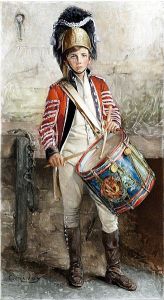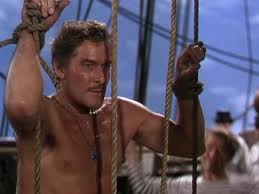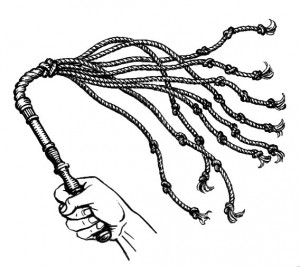Flogging as a form of punishment was dispensed by company drummers during the American Revolution. In my recent post on flogging, I included the following statement:
…the desired outcome of flogging wasn’t usually the recipient’s death. That meant that often the flogging was delivered by a boy who didn’t have the upper body strength of a man.
A history buff queried me about the statement, said that all drummers were adults, and wanted to know where I’d gotten the rationale about using boys to go easy on the punishment.
One place I’d seen it was in Dr. Tony Scotti’s 2002 book Brutal Virtue: The Myth and Reality of Banastre Tarleton. Here’s the quote from his book:
Starting in 1740, some restraints appeared during floggings. Soldiers lived through large numbers of lashes, say one thousand for desertion, because they were administered at intervals over several weeks and supervised by a surgeon. Furthermore, drummers now carried out the punishment. The rationale for all this is simple. Aside from being more humane, it saved a valuable if momentarily wayward soldier for future service. In addition, a drummer boy of thirteen or fourteen years of age did not have the upper body strength of an adult corporal or sergeant. The youth could not last long at full tilt when whipping his comrade.
I bolded the portion of the quote most pertinent to this post and will get to the issue of drummers’ ages in a moment. This bolded part supplies a rationale that drummer boys administered floggings because they didn’t have an adult’s upper body strength and could thus go easier on the prisoner. Documentation exists to support the points about the flogging intervals, surgeon supervision, and duty of drummers. But the rationale itself doesn’t appear to have primary documentation supporting it. (If you find such a source, please send it to me.)
Years after the Revolution was over, that rationale may have been acquired to supply a motive or reason for why boys were involved in the business of floggings. How would a rationale be attributed? Unfortunately, people have “embellished” pieces of history all along to support personal and organizational agendas. If you don’t believe in these agendas, take a look at “Molly Pitcher.”
Here’s where matters get murkier. It’s a fact that units enlisted boys as young as twelve years of age. I checked into some primary sources—pension applications and, via a fellow researcher, muster rolls—to see what they could tell me about the ages of drummers. In both the British and Continental armies, there were plenty of adult drummers. However, boy drummers also became members of units as early as twelve years old. So were all drummers adults? No.
 Life on a campaign trail was obviously harsher than that in garrison. Any boy who could endure the rigors of battle as a drummer and march all day carrying a heavy drum would have to be strong and stout. Such a boy would be expected to perform all the duties of a drummer. Most likely he’d be older than twelve—but that doesn’t mean he’d necessarily be a man. One pension application I read included a direct reference to the drummer flogging someone, and when he did it, he might have been fifteen years old. Tantalizing data.
Life on a campaign trail was obviously harsher than that in garrison. Any boy who could endure the rigors of battle as a drummer and march all day carrying a heavy drum would have to be strong and stout. Such a boy would be expected to perform all the duties of a drummer. Most likely he’d be older than twelve—but that doesn’t mean he’d necessarily be a man. One pension application I read included a direct reference to the drummer flogging someone, and when he did it, he might have been fifteen years old. Tantalizing data.
We don’t yet know why drummers were chosen to administer floggings. Nor do we know if there was a minimum age requirement to perform the duty. In a unit, drummers were rotated through the task of flogging. If a prisoner was to receive a great number of lashes, several drummers could be assigned to carry out the sentence. Thus some boys may have been included in the duty rotation and wielded the cat-o’-nine-tails. Such circumstances don’t support the rationale that armies used drummer boys for a light touch with the whip.
Why would this rationale be attributed in the first place? For Americans living in the past century, the ideas of enlisting children as combatants, whipping a man’s back to shreds as corporal punishment, and using children to dispense such floggings are alien, horrific, and repulsive. But that level of social consciousness didn’t exist in the 18th century. The notion that boys were assigned to deliver floggings because they didn’t have the upper body strength of a man sounds like a very modern attribution. Maybe it’s an “agenda” to soften some grim realities: that “childhood” looked very different during the American Revolution, and that corporal punishment was brutal business in the British and Continental armies.
**********
Did you like what you read? Learn about downloads, discounts, and special offers from Relevant History authors and Suzanne Adair. Subscribe to Suzanne’s free newsletter.




